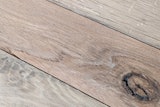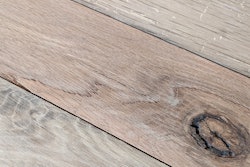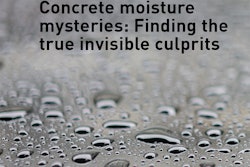
Major Modification
I heard someone talking about a thermally modified wood floor. What is that?
Kevin DeMars, principal at Wilmette, Ill.-based Thermory USA, answers:
Thermally modified wood products have been widely used for over 20 years in Germany, Austria, Norway, Switzerland, Japan and Italy for interior and exterior use. Not all thermo-wood producers are the same, however, as the process is extremely difficult to master.
Developed and refined in Europe, thermal modification is a highly technical computer-controlled process carried out in specially designed high-temperature kilns. Only heat and steam—no chemicals—are used, which makes the process green. It produces material with outstanding dimensional stability and rot-resistance because of how it changes the cellular structure of the wood. The cells in wood that transport water have that ability reduced. Sugar content in the cells—the food source for mold and fungus—is reduced, as well.
Additionally, the color of the wood is transformed, and this color extends throughout the thickness of each board. The color of “medium-treated” wood varies from light to golden brown, while the “intense-treated” wood is a chocolate brown. Because of their stability and color change, thermally modified products are considered an environmentally friendly alternative to engineered and exotic products.
Conventional wisdom is still needed during installation of this wood flooring, with moisture barriers being critical for successful performance. Installation may need some extra care because the wood can be slightly brittle (poor thermally modified materials will be nearly impossible to work with). Properly modified woods do not change hardness, so sanding should not change, although the dust tends to be the consistency of powder. Thermally modified wood will accept stains and finishes just as easily as conventionally kiln-dried products.
Permanent Gaps?
I got a call from a customer upset that her solid floor I installed last summer had big gaps this fall, and now they are getting even worse. Will the gaps go away in spring?
Rusty Swindoll, assistant technical training director at the National Wood Flooring Association, answers:
 Attempting to fill big wood floor gaps with filler will simply result in the filler cracking and falling out.
Attempting to fill big wood floor gaps with filler will simply result in the filler cracking and falling out.
Questions like this really come back to installers understanding what “acclimation” means. A wood floor being “acclimated” and ready for installation means that the flooring and subfloor moisture content are within four percentage points of the subfloor (for strip) and two points (for plank) when the home is at normal living conditions. The only way to know this is to use your moisture meter!
If the gaps don’t close up during normal conditions in summer and they are unacceptable, you don’t have many options. Gaps that are too wide will not hold filler, and the flooring may have to be replaced.
Resanding Prefinished
I have a customer with a prefinished floor, and he wants to change the stain color. Is there anything I should be aware of when resanding?
John Dupra, vice president at Installers Warehouse in Rochester, N.Y., answers:
The first step when you do any resand, whether a solid or engineered floor, is to check the wear layer. Is there enough wood left to sand it? This depends on the condition of the floor, the big machine and abrasive used, and the skill of the operator. In general, about 2 millimeters is the bare minimum to even consider doing a resand.
Next you need to think about your sanding sequence. Most of today’s factory-finished floors have extremely hard finish: They have been coated multiple times, are UV-cured in ideal factory conditions and usually contain aluminum oxide, which can be extremely difficult to sand off. I suggest doing a test area on the floor with a typical resanding grit, such as 36. If it doesn’t cut the floor like you’d expect, you’re probably dealing with one of these hard finishes. In that case I suggest starting with a finer grit, such as an 80. Using this as your first grit damages the structural integrity of the finish. Once that is done, you can go back to your lower grits and sand down to bare wood.
This technique is counter-intuitive, but I sometimes use the analogy of a block of ice. If you use a large mallet to hit the block of ice, it will probably bounce off, but if you use a small ice pick to create cracks throughout the block, the big mallet will then break it right up. The particles on your abrasive work on aluminum oxide finishes in much the same way.
































